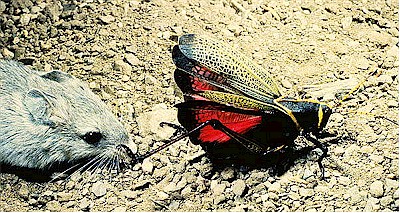
dwwhitm@ilstu.edu
Insect ecology, behavior, and physiology; Chemical ecology; Interactions of insects, plants, predators, and parasitoids; Thermoregulation and water balance.
Research in my laboratory seeks to understand the adaptations of insects to the physical and biological challenges of a hostile environment. We study adaptations from both mechanistic and evolutionary perspectives, and are currently initiating new projects on insect attration to floral odors, defensive chemical ecology of noxious insects, and grasshopper biology. In the past we examined thermoregulation and water conservation in desert vs. swamp-inhabiting grasshoppers, insect chemical defense, tritrophic chemical communication, grasshopper sexual, feeding, and roosting behaviors, insect sex and aggregation pheromones, and mimicry. Students in my laboratory work in Illinois, Florida, Arizona, and Mexico.
 |
John Hatle. I am studying grasshopper phenotypic plasticity and the evolution of chemical defense ensembles.
Tim Stauffer. I am comparing oviposition behaviors and egg physiologies in desert vs. swamp-inhabiting lubber grasshoppers. Also, I am investigating the chemical, visual and tactile factors that elicit group oviposition in these insects.
Bryan Krall. I am studying the defensive chemical ecology of several species of true bugs. The insects spray a noxious mixture of aldehydes, esters, and terpenoids when attacked by predators.
Cara Lewis. I am studying sexual behavior in grasshoppers and the effects of males on female fecundity. Males will copulate for up to 5 days continuously -- which, I believe, is among the longest of copulation times for males of any species!
Mike Walker. I am studying the attack behavior of a tachinid fly that parasitizes lubber grasshoppers.
Dan Otto. I study tachinid parasitization in lubber grasshoppers. I've found up to 63 maggots in one live (although unhappy) grasshopper. Surprisingly, females with up to 25 maggots can still lay eggs.

Krall, B. S., R. J. Bartelt, C. J. Lewis, and D. W. Whitman. 1999. Chemical defense in the stinkbug Cosmopepla bimaculata. Journal of Chemical Eclolgy 25: 2477-2494.
Walker, M., C. J. Lewis, and D. W. Whitman. 1999. Effects of males on the fecundity and fertility of female Romalea microptera grasshoppers. Journal of Orthopteran Research 8: 277-283.
Chladny, T. A. and D. W. Whitman. 1998. The effects of temperature, soil moisture,and ventilation on the eggs of the grasshopper Romalea guttata. Transactions of the Illinois State Academy of Sciences 91:155-159.
Stauffer, T. W., S. G. Hegrenes, and D. W. Whitman. 1998. A laboratory study of oviposition site preferences in the lubber grasshopper, Romalea guttata (Houttuyn). Journal of Orthopteran Research 7:217-221.
Chladny, T. and D. W. Whitman. 1997. A simple method to culture grasshopper eggs with long egg diapause. Journal of Orthopteran Research 6:82.
Polanowski, A., M. S. Blum, D. W. Whitman, and J. Travis. 1997. Proteinase inhibitors in the nonvenomous defensive secretion of grasshoppers: antiproteolytic range and possible significance. Comprehensive Biochemistry, and Physiology 117B:525-529.
Stauffer & Whitman. 1997. Grasshopper oviposition. In: S. Gangwere (Ed). The Bionomics of Grasshoppers. CABI, New York.
Whitman & Nordlund. 1994. Plant chemicals and the location of herbivorous arthropods by their natural enemies. In: T. Ananthakrishan (Ed). Phytophagous Insects. Oxford & I.B.H.
Whitman. 1994. Plant bodyguards: Mutualistic interactions between plants and third trophic level. In: T. Ananthakrishan (Ed). Phytophagous Insects. Oxford & I.B.H.
Yosef and Whitman. 1992. Predator exaptations and defensive adaptations in evolutionary balance. Evol. Ecol. 6:527-536.
